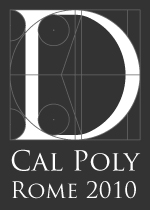This map shows a portion of the plan for the new center of Rome. This site has historically held significance as the center of Rome but today does little to unify or create a heart of the city. Remnants of a marker in the Ancient Forum signify the spot that all distances in the Roman Empire were measured from. The Campodoglio, the political and social center of 16th– 19th century Rome, sits partially on this site. The Vittorio Emmanuele Monument, from the turn of the 20th century, tries to establish itself as a city center, but is seen a grotesque and overpowering object. This project looks to other ‘centers’ of Rome, St. Peter’s, Piazza del Popolo, the Coliseum, etc., to pull various elements from each of them, while appropriately applying them to this site context.
This plan attempts to unify this site as a historical, cultural, and tourism center of Rome, a projection into Rome’s future. Much of what is now the Ancient Forum is covered and built over as the city expands into this last remaining open space, a phenomenon we can see in the differences between the Nolli Plan of 1762 and maps and images of the city now. Rather than filling in the ruins, the new urban growth is built above them on piloti, allowing the ruins to remain accessible. This forces architecture to take a stand on the relationship between the past, present, and future. The new urban growth would need to cater to the needs of both tourists, an influential part of Roman life, and the citizens of Rome.
A new piazza also fills a portion of the site, a gathering space for tourists and citizens alike. This piazza becomes a hub for circulation to the other centers of Rome in a larger plan for the city. The Vittorio Emmanuele Monument, which now stands at nearly 250 feet tall, gets clipped almost in half and becomes a vertical extension of the piazza. This removes the dominance of the monument over the city and allows people to see all of Rome from it. A series of monuments line the piazza that tell the stories of significant moments in Rome’s history. A prime example of this is Trajan’s column, that tells the stories of his wars, which is actually incorporated into the storyline of the new piazza while remaining in situ.
The circulation near the site also changes drastically as this area becomes the new center of Rome. The road that leads southeast from the piazza towards the Coliseum becomes primarily pedestrian, only the vehicles needed to support these areas are allowed to enter. Vehicle access, and therefore traffic, is removed from new piazza and rerouted as part of the larger city plan. A tunnel cuts across the ancient ruins on this site, situated above their floor but underneath the new urban growth. This tunnel links two sides of the city that were previously divided by the Ancient Forum and also serves a structural element that supports new urban growth above it.

